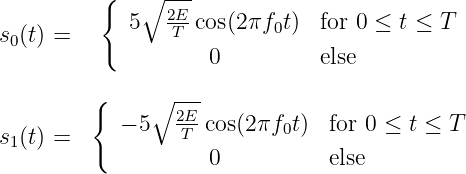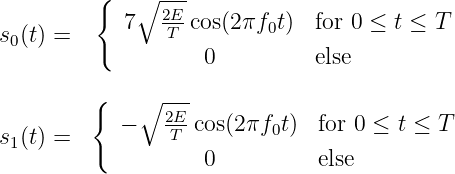- Chapter 6, section 6.2.
Signal Set Design
The following binary signal set is used to transmit equally likely messages over an additive white Gaussian noise channel (spectral height ),
),

- Draw a block diagram of the optimum receiver.
- Compute the probability of error for this receiver.
- Repeat parts (a) and (b) for the following signal set:

- Sketch and accurately label a signal space diagram, including decision boundaries, for each of the two signal sets above.
- Verify that both of the above signal sets use the same average
bit energy
E b = . Then compare their performance with
respect to the minimum probability of error. Explain any
differences. Which signal set do you prefer?
. Then compare their performance with
respect to the minimum probability of error. Explain any
differences. Which signal set do you prefer?
Non-Ideal Channels
The following two signals are used to transmit equally likely messages over a channel with AWGN of spectral height .
.

- Sketch the simplest possible block diagram of the optimum receiver and compute the probability of error attained by your receiver.
- For the remainder of the problem, assume that the
transmitted signal is filtered by a linear filter with impulse
response

before the noise is added. The following block diagram summarizes this channel.

Sketch the two possible received signals under the assumption that there is no noise.
- If the impulse response is unknown at the receiver, a reasonable
approach might be to continue to use the receiver from part (a)
which assumes that
h (t ) =δ (t ). Compute the probability of error that your receiver from part (a) achieves if the actual channel impulse responseh (t ) is as given above and the noise spectral height is .
.
- If the channel impulse response
h (t ) is known at the receiver, can you design a better receiver than the one in part (a)? If yes, draw a block diagram of the new receiver and compute the associated probability of error. If no, explain why not.
M-ary Signal Sets
The following signal set is used to transmit equally likely messages over an additive white Gaussian noise channel with spectral height ,
,

Thus, this signal set consists of
M = 2 signals.- Draw and accurately label a block diagram for the optimum receiver for this signal set.
- Draw and accurately label the signal constellation in an appropriately chosen signal space and indicate the decision boundaries formed by the optimum receiver. Then, compute the probability of error achieved by the optimum receiver.
- Repeat part (b) for the following signal set with 4 signals

- Repeat part (b) for the following signal set with eight signals

Bonus: Derive a general expression for the probability of error of theN -dimensional signal set with 2N signals
M-ary Signal-Set
The following three signals are used to construct a signal set for transmission eight equally likely signals over an additive white Gaussian noise channel with spectral height :
:

Specifically, the eight signals are constructed as linear combinations of the three signals above:

where each of
l ,m , andn can be either equal to zero or one.- Sketch and accurately label all eight possible signals.
- Draw and accurately label a block-diagram of the receiver which minimizes the probability of error for this signal set.
- Draw and accurately label the the signal set in an appropriately chosen signal space. Indicate the decision boundaries and state clearly which basis functions span your signal space.
- Find the probability of error the optimum receiver achieves with this signal set.
- Give a different signal set which achieves the same probability of error as the signal set above.